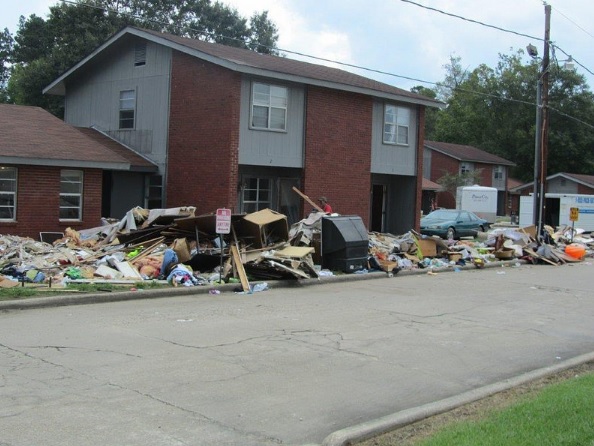Affordable Housing Activists Brace For Funding Crunch Under Trump Administration
The National Low Income Housing Coalition anticipates major reductions in federal housing spending during Trump's presidency - but they also see potential funding opportunities arising from his infrastructure investment proposals.
 |
| A LOOMING LOW-INCOME HOUSING CRISIS? Representatives of the National Low Income Housing Coalition fear major cuts to HUD and USDA housing and rental assistance programs under Trump's presidency, but they remain optimistic that programs can stay afloat through nontraditional funding streams - including mortgage interest deduction reform. (Photograph courtesy the United States Department of Agriculture.) |
By: James Swift
UncommonJournalism@gmail.com
@UNJournalism
Regardless of who won the general election, National Low Income Housing Coalition (NLIHC) President and CEO Diane Yentel said the nation's dearth of affordable housing units would remain a grave concern.
"There is a gap of 7.2 million units of housing affordable and available to the lowest-income people," she said in a Dec. 2 webinar. "Seventy five percent of the lowest-income families - these are families with kids, vets, elderly people, people with disabilities - they're paying half their income on rent, leaving little left for food, medicine and other necessities."
With Donald Trump's election and Republican lawmakers gaining control of both houses of Congress, Yentel said she fears major cuts to Housing and Urban Development (HUD) and United States Department of Agriculture (USDA) rental and housing assistance programs are all but inevitable.
The Center on Budget and Policy Priorities recently released findings that, adjusted for inflation, funding for HUD's housing assistance and community development programs has decreased by an average of 10 percent over the last seven years, with the 2016 fiscal year budget roughly 6 percent lower than the department's budget in 2010.
Other NLIHC staffers worry about even deeper housing program reductions under President-Elect Trump, whose "penny plan" looks to cut federal spending on everything except national defense, Social Security and Medicare and Medicaid services to achieve a total federal budget decrease of one percent a year over the next 10 years.
"For fiscal year 2017, HUD needs $1.5 billion in additional funding over the amount provided the previous fiscal year," said NLIHC Senior Policy Analyst Elayne Weiss, "and the United States Department of Agriculture's rural housing service needs an additional $18 million just in order to maintain existing rental assistance, contract and funding levels."
At the heart of the matter, Weiss said, is the congressional plan to pass a continuing resolution (C.R.) to keep the government funded through the spring.
She said the C.R. is likely to run through April 2017 to accommodate the confirmation process for Trump's cabinet appointees. It would also prevent Congress from making any final funding decisions until Jan. 20, the date of Trump's inauguration.
That scenario, Weiss said, could result in a C.R. being passed with funding locked at fiscal year 2016 levels. If that happens, she said more than 100,000 housing choice vouchers could be lost.
That's exactly what happened the last time sequestration budget cuts took full effect in 2013, Weiss continued - in addition to 60,000 fewer people receiving HUD homeless assistance grants, cuts to all community block grants and a steep reduction in public housing capital improvements.
"The Government Accountability Office found that due to the $400 million cut to the Project-Based Rental Assistance program (PBRA) brought about by sequestration," Weiss said, "HUD short-funded contracts with 800 private owners, representing almost half the PBRA portfolio."
Death by a thousand cuts?
Low-income housing programs could also take a financial hit via the Budget Control Act of 2011, which places tight spending caps on the federal budget beginning fiscal year 2018.
"It's going to be very difficult to see an expansion of housing programs for appropriation," Weiss said.
She champions The Affordable Housing Credit Improvement Act, a bipartisan bill penned by Sen. Maria Cantwell (D-Wash.) and Sen. Orrin Hatch (R-Utah) that would expand the Low-Income Housing Tax Credit and increase the number of units available under the current program by 400,000 over the next 10 years. However, with Trump's aspirations to reduce the corporate tax rate to as low as 15 percent, Weiss said she nonetheless fears the program could be an easy target for budget cuts.
She's also deeply concerned about poverty increasing under Paul Ryan's "A Better Way" plan - particularly, a provision that would place both work requirements and time limits on those who receive housing assistance. "We've seen similar efforts when welfare reform was done in the '90s," Weiss said, "and the results were pretty clear that this had a very negative effect on many low-income households."
Another potential obstacle, she said, is appropriations language that could potentially roll back HUD's efforts to implement its Affirmatively Furthering Fair Housing (AFFH) rule.
"The pressure appears to be mounting and a lot of conservative leaders see this as 'social engineering' and 'government overreach,'" Weiss continued." That includes staunch critics like Ben Carson - the man Trump named as his selection for HUD Secretary on Dec. 4.
Weiss defended the AFFH regulations.
"Many Republicans, including House Speaker Paul Ryan, are interested in promoting economic mobility," she said, "and the AFFH rule and the tools they put out are really going to help communities think more about how they can increase that economic opportunity locally."
The National Housing Trust Fund (NHTF) could also be a target "from multiple angles," said NLIHC Director of Policy Sarah Mickelson, with the budget reconciliation process representing the biggest threat.
"Tax reform is likely to be at the top of the agenda," she said. "That would allow them to make changes to both the revenue side and mandatory spending, but only need 51 votes in the Senate to do so ... the decision hinges on whether or not members of the Banking Committee and the House Financial Services Committee identify the Housing Trust Fund as a possible offset."
The trust fund could also be an appropriations casualty. It's happened before, Mickelson noted, like in 2015 when Congress used NHTF funds to plug holes in the HUD budget.
"There's going to be a lot of pressure on them to do the same thing this year," she said.
There's even a likelihood the NHTF authority could be repealed outright, Mickelson stated. That would be a huge mistake for Republican lawmakers, she added, saying that the program "fits snugly" with what conservative legislators generally look for in federal services.
"It operates as a block grant, it allows a lot of local control in terms of deciding which projects to fund and it's highly targeted to serve people who have the greatest and most acute housing needs," she said, "which the private sector just cant reach."
Much ado about the MID?
Created in 2008, the first wave of NHTF allocations were distributed by HUD in 2016. Of the $174 million allocated, Yentel said roughly three-quarters of the funding went to subsidize homeowners, while about a quarter went to low-income renters "with the greatest and clearest needs."

More than 2,000 organizations and elected officials have endorsed the NLIHC's United for Homes Campaign, which supports "smart, modest reform" to the mortgage interest deduction (MID) to increase tax benefits for low-income homeowners and create new funding streams to expand other affordable housing programs, such as the the NHTF and Section 8 vouchers.
Yentel proposes two major changes to the MID program. First is lowering the size of a mortgage from which interest can be deducted from $1 million to $500,000.
"The change would impact fewer than 5 percent of mortgage holders nationwide and it would save $95 billion over 10 years," she said.
The other change is adjusting from a deduction to a non-refundable tax credit with a percentage of annual interest. "That change would make the tax benefit of home-ownership available to 15 million more lower-income homeowners," she said, "who currently, don't get any tax benefit."
Combined, she said the two MID changes would save $241 billion over a decade.
While Republican lawmakers may have been reluctant to reform the MID in years past, Yentel said the issue has gone from being an untouchable third rail to a negotiable element of comprehensive tax reform for conservative legislators. Indeed, Weiss notes that both Paul Ryan's "A Better Way Plan" and David Camp's comprehensive tax reform plan - both of which are likely to be used by the House Ways and Means Committee as starting points for any fiscal year 2017 tax reforms - are both fairly open to MID reform.
While the G.O.P. may be receptive to possible MID changes, Yentel says there is still immense resistance from the private sector.
"The real estate industry is monolithic and the home-builders and the National Association of Realtors remain strongly opposed to any kind of changes," she said. "They sought from candidates who would receive their endorsements, commitment to retaining the MID as it is is ... that opposition is real and it's strong."
A silver lining in infrastructure spending?
Representatives of the NLIHC may be apprehensive about the fate of federal housing programs under the Trump Administration, but they do feel cautiously optimistic that affordable housing could nonetheless become a focal point of the president-elect's ambitious infrastructure plans - which have been tabbed at $1 trillion over the next 10 years.
"I think there's a lot of possibilities for what could be in an infrastructure package," Weiss said. "Transit-oriented development, I think, is another possibility and opportunity ... we would want to see if any kind of housing dollars that are proposed in that way are targeted for the lowest income people."
However, Weiss notes that many Republicans on Capitol Hill aren't so eager to pass the $100 billion a year spending package. And per Mickelson, how that package manifests itself - will it come in the form of a more formal direct spending package or an infrastructure tax credit? - certainly influences the extent to which affordable housing may be funded.
"We feel very strongly that any infrastructure package should also include funding to increase resources for affordable housing," Mickelson said. "Like roads and bridges, affordable housing is a long-term investment that really help communities, the economy and families thrive."
But there are still more questions than answers. Would Trump's infrastructure plan expand the NHTF, or create more housing vouchers, or beef up funding for public housing repairs or even allow HUD access to a potential national infrastructure bank?
Like everyone else, Mickelson said the NLIHC is still in the dark. And the irony that affordable housing continues to shrink in the communities where Trump picked up his most resounding electoral victories - according to USDA data, the nation's rural rental portfolio has decreased by at least 5 percent since 2012 - is not lost on her.
"Rural housing tends to be overlooked in lots of ways at the federal level, and so there's definitely a need to address both homelessness and housing affordability in those communities," she said.
It's a sentiment echoed by Yentel - and much more directly.
"I can say with certainty, without overlaying the results of the election with the map," she said, "that there is an affordable housing crisis in the communities that voted for Trump."
Uncommon Journalism, 2016.



Comments
Post a Comment